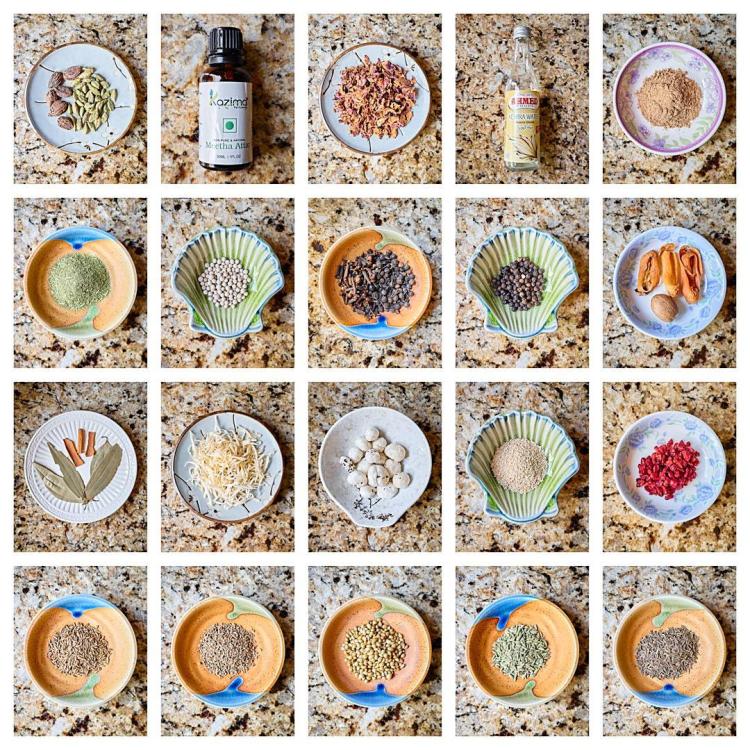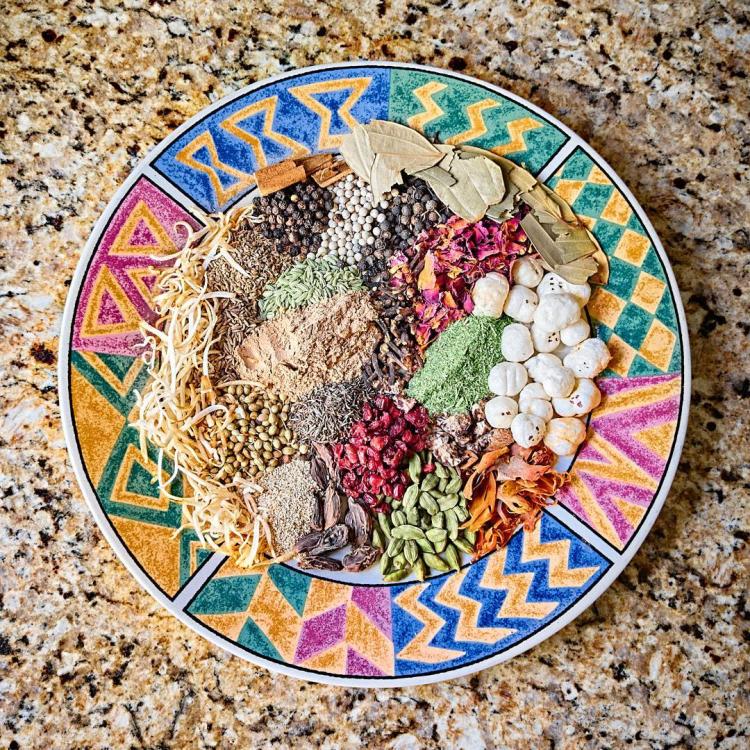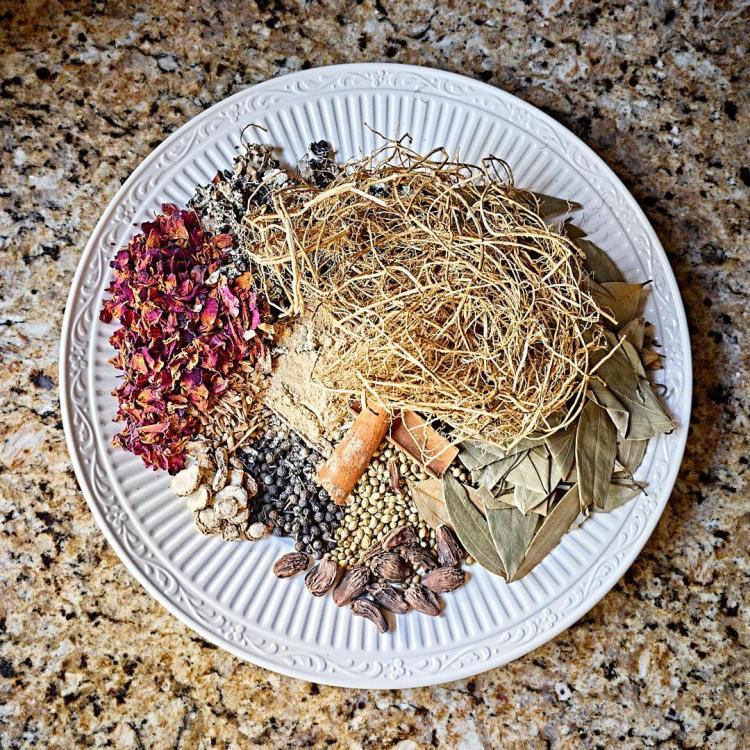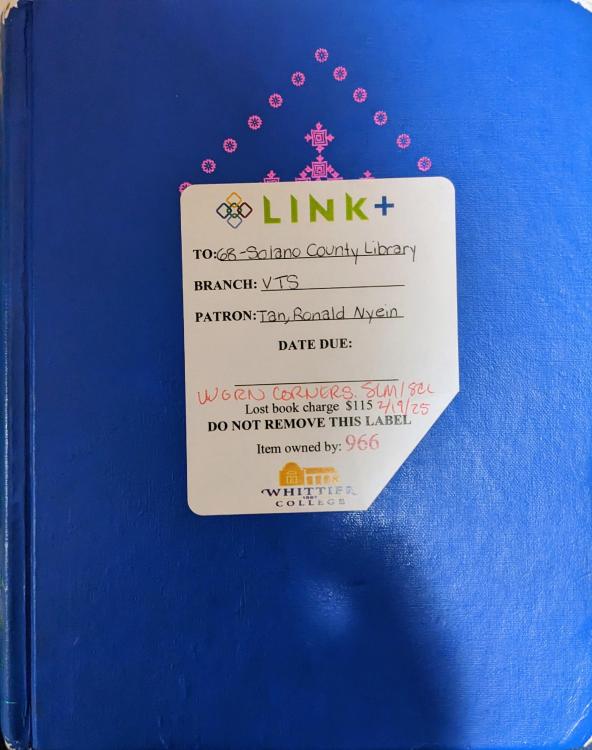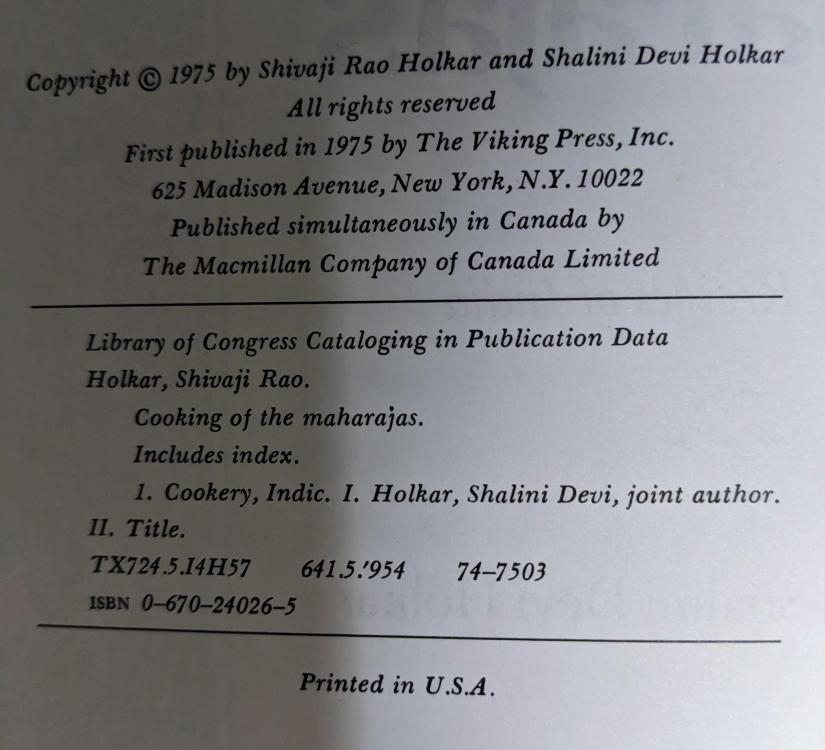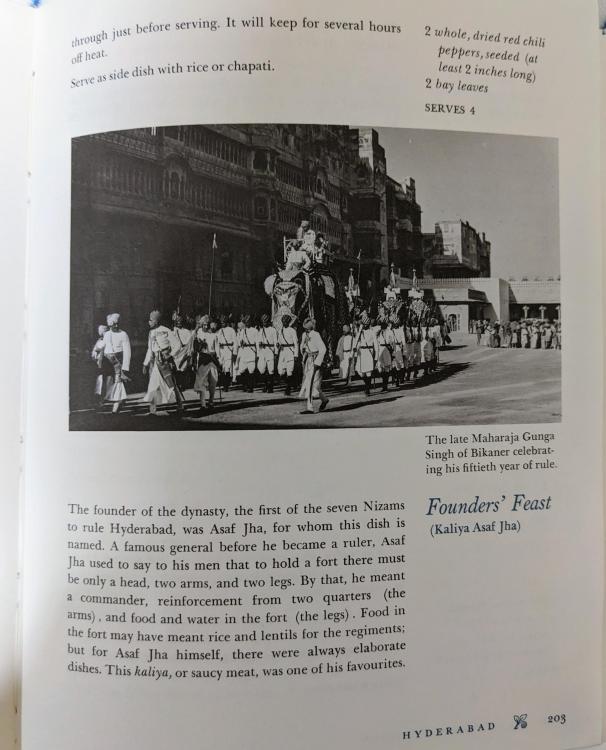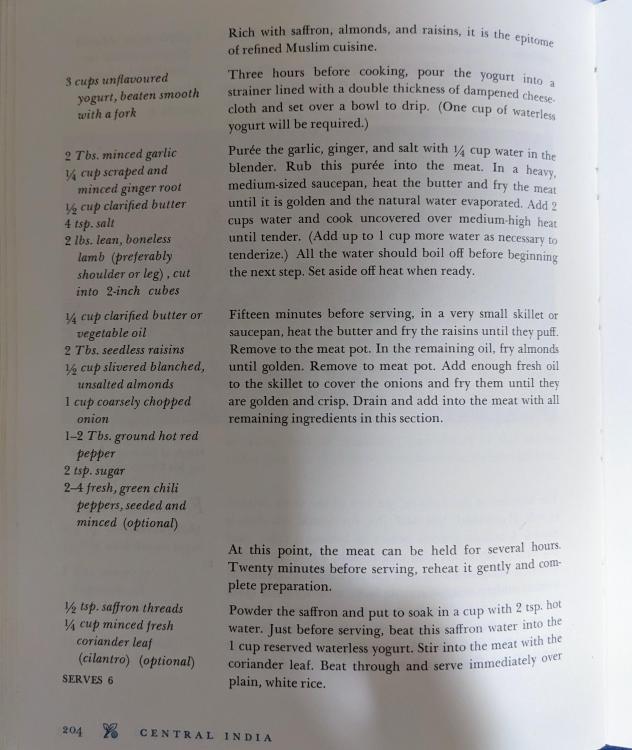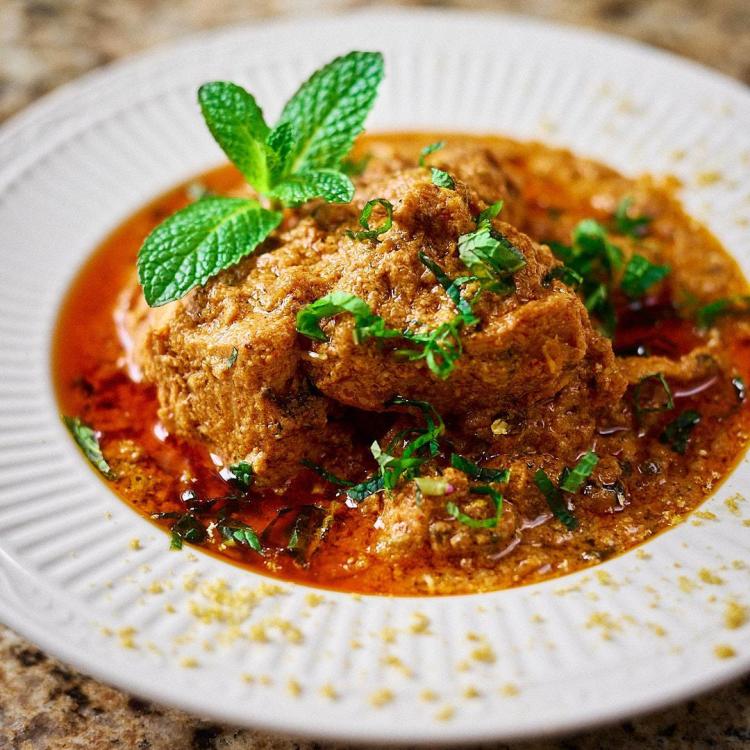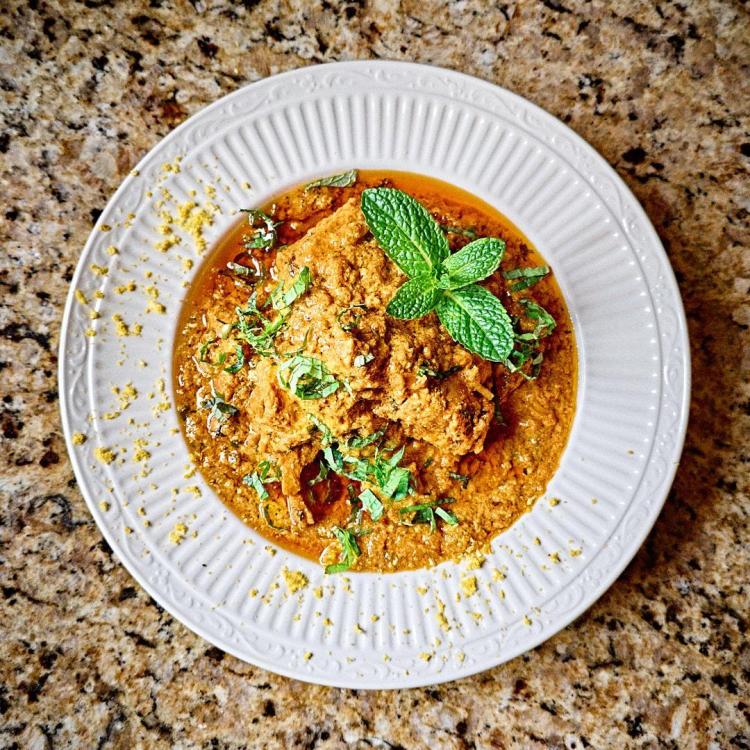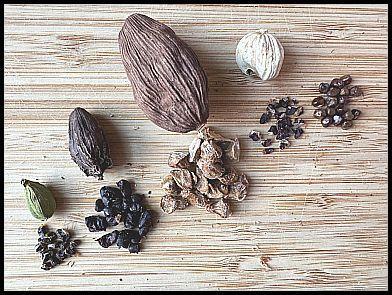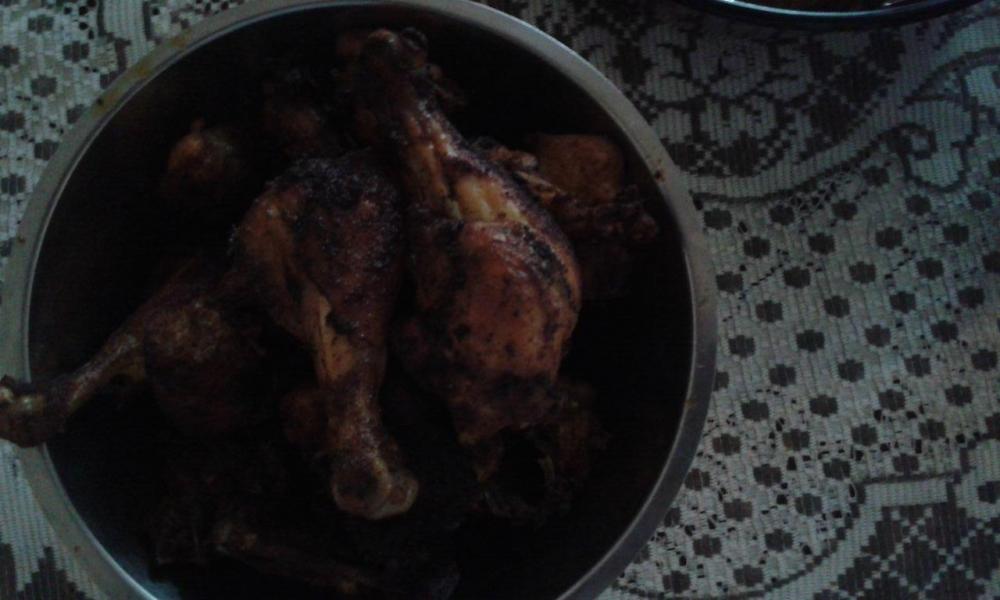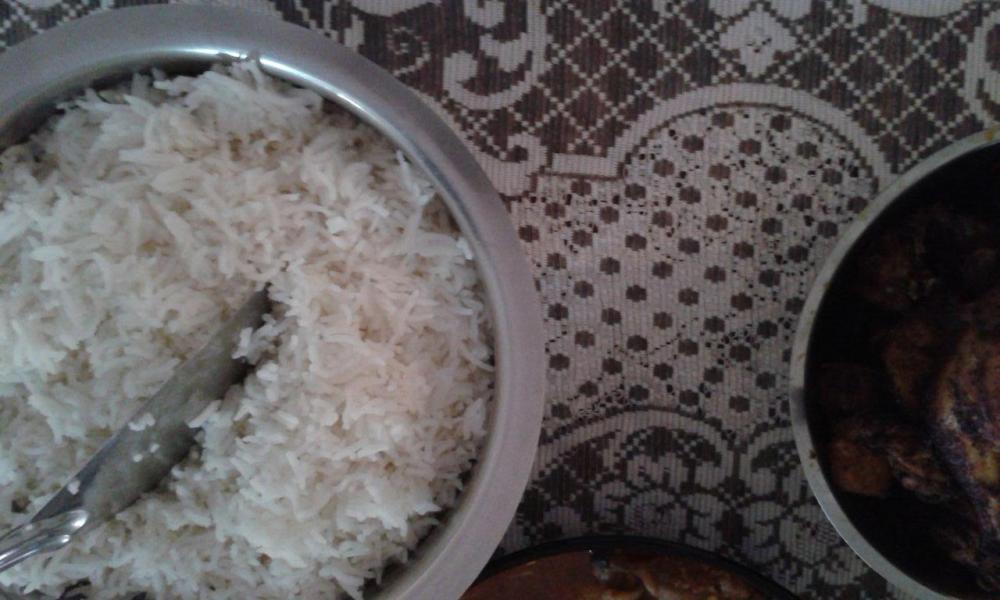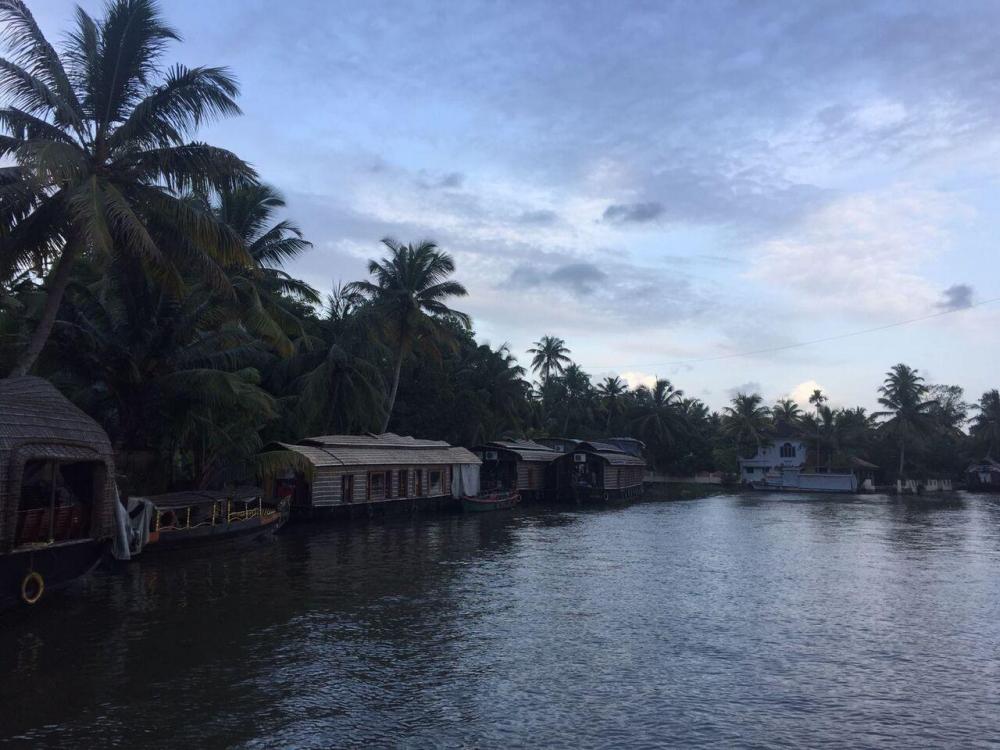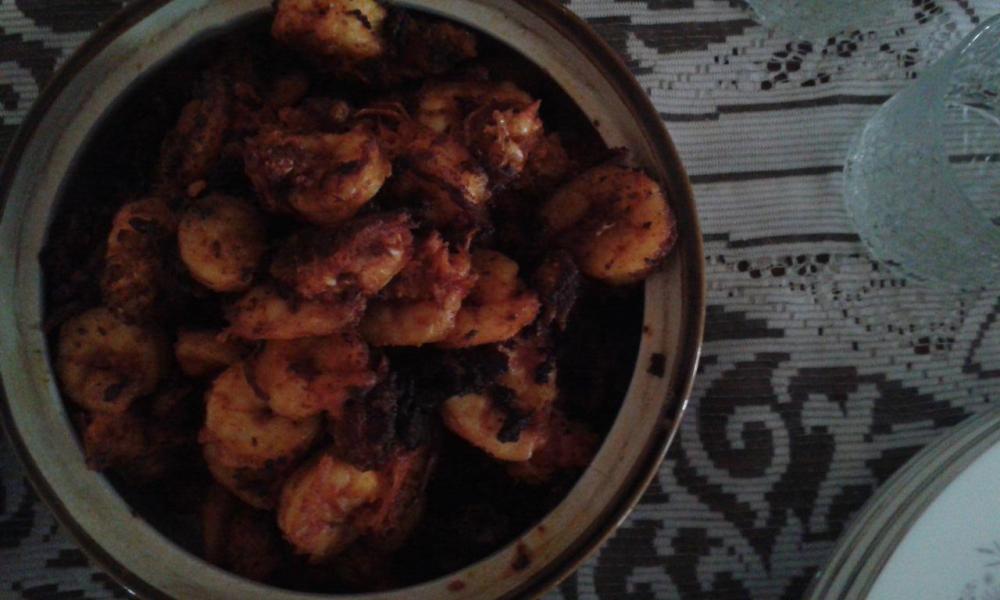Search the Community
Showing results for tags 'Indian'.
-
I've been noticing green[but not fresh]chickpeas in local N.Y. Indian markets lately.What is special about them,and how are they best prepared?Sprouted first?
-
As-salaam alaikum everyone. Namaskar(am). Vanakkam. Adaab. Sat sri akal. Greetings from Northern California (USA). My name is Ronald N. Tan, but when cooking, I use my food name of "Tan Can Cook." I would like to start this post and topic for sharing and showcasing the various regional spice blends from India. There is more to spice blends from India than your garam masala, curry powder, etc. I would like to start my post with what I consider to be spice blends that showcases and epitomizes not only India's affluent culinary history, but the collective khansamas and bawarchis culinary creativity. To showcase the complex and layered spice blends, I will share them in the form of mise en place, along with the full recipe of the ingredients. As a masalchi, I am learning and exploring regional spice blends from India, Pakistan, Bangladesh, and Iran. If you have questions or clarifications, please ask in this topic. The recipes are sourced from my personal library of cookbooks sourced direct from India. Lazzat-e-Taam from Dastarkhwan-e Awadh: The Cuisine of Awadh लज़्ज़त-ए-ताम By Tan Can Cook Modified and Adapted from Sangeeta Bhatnagar and R. K. Saxena Ingredients 7 g green cardamom 5 g black cardamom 5 g barberries [Berberis vulgaris] 5 g sandalwood powder, culinary/edible grade [Santalum album] 5 g coriander seeds 5 g lemongrass [Cymbopogon spp.] 5 g cumin seeds 5 g black cumin seeds [Elwendia persica] 5 g cubeb [Piper cubeba] 5 g grated coconut 5 g black pepper 5 g white pepper 5 g poppy seeds 5 g cloves 5 g fox nuts [Euryale ferox] 5 g anise seeds 5 g fennel seeds 3 g mace 1 whole nutmeg 3 g dried rose petals 2 g cinnamon 1 g Indian bay leaves [Cinnamomum tamala] Dried fennel leaves 13 g (1 tbsp) kewra water 11 g (1 tbsp) meetha itr (culinary grade food perfume; I use Deer-brand meetha itr sourced from Kolkata, West Bengal. I don't have any luck finding sellers from Lucknow who would source and ship to the USA) Method Gently roast all dry ingredients over a low flame until fragrant. Remove from heat and grind to a fine powder. Sieve the mixture, then add kewra water and meetha itr. Rub the mixture between your palms and sieve again. If still moist, dry indoors before storing in an airtight jar. Hyderabadi Potli ka Masala from A Princely Legacy Hyderabadi Cuisine हैदराबादी पोटली का मसाला By Tan Can Cook Modified and Adapted from Pratibha Karan Ingredients 50 g coriander seeds 8.75 g dried vetiver roots [Vetiveria zizanioides] 8.75 g Indian bay leaves [Cinnamomum tamala] 8.75 g lesser galangal [Alpinia officinarum] 7.5 g cubeb [Piper cubeba] 7.5 g black stone flowers [Parmotrema perlatum] 6.25 g sandalwood powder, culinary grade [Santalum album] 6.25 g black cardamom 6.25 g whole wheat grains 6.25 g spiked ginger lily roots [Hedychium spicatum] 5 g dried rose petals 3.75 g cinnamon Method Mix these spices and herbs in the given proportions and divide into portions. At the time of use, tie a portion in a muslin cloth or in any thin cloth for insertion in the dish. Use one or more portions as may be required. Store in an airtight jar to prevent insects from getting into the mix. Alternatively, I prefer to ground them into powder and use accordingly in powdered form. Traditionally, they are used as bouquet garni and added into to make broth, flavored water, base, etc.
-
Namaskar(am). As-salaam alaikum. Adaab. Sat sri akal. Vanakkam. Nomoskar. Salam! Hello from Northern California (USA). My name is Ronald N. Tan; I am a home cook (personal chef) with a laser-focused culinary interest in regional Indian, Pakistani, Bangladeshi, and provincial Iranian (Persian) cuisines. My aim is to foster and cultivate discussion while disseminating and sharing knowledge on sourcing rare, specialty spices and herbs—compulsory and outside of India—so that recipes from regional Indian cookbooks published in India can be reproduced 1:1, with viable substitutions and minimal omissions. I will be updating this post in “bite-sized” threads. Please consider following or watch this thread for updates and discussion. I am not affiliated with any of the merchants or online stores. In accordance with eGullet forum regulations, the provided links direct to the original sources. They are intended solely as references to expand and enrich our collective knowledge of the culinary arts! As this is my comprehensive and detailed source list, please perform your due diligence. I will not be responsible for any issues encountered, as individual shopping experiences may vary. Spices and herbs should be purchased in whole form whenever possible, stored in airtight glass containers, and kept away from light. To maximize spice potency, slow toast over low heat to activate their essential oils. To achieve finer grounds, sieve using the smallest mesh. Place the larger pieces back into any grinder and repeat as necessary. For handling harder spices and herbs, e.g. dried vetiver roots (Chrysopogon zizanioides / Vetiveria zizanioides), lesser galangal (Alpinia officinarum), or spiked ginger lily (Hedychium spicatum), a heavy-based granite mortar and pestle is necessary. Repeating (2) and (3) as necessary. Support your local South Asian (Desi) and Middle Eastern grocers. Their contribution to enhancing and diversifying our culinary culture is paramount and often understated—source common ingredients locally whenever possible. Establish relationships with the owners and managers of these stores, as they are invaluable sources of insight and can recommend the highest-quality products. Only resort to online sources when local options have been exhausted.
-
Inspired by a similar thread under 'General Food Topics', I wanted to know how many Indian cookbooks we collectively own on this forum. I have 43 right now, but I'm sure more will turn up from under the bed etc. I'm particularly curious about your collection Vikram, because you seem to own every Indian cookbook under the sun. Here's a picture of my very modest collection (a few on the left haven't come in the shot) This is in the kitchen, although there are not that many Indian books here ('Indian Everyday' is from the library) except the small booklets at the end.
-
First, My Commentary Shivaji Rao Holkar is the short form name of Maharajkumar Shrimant Shivaji Rao Holkar of Indore (aka Prince Richard Holkar). Shalini Devi Holkar (Princess Sally Holkar) is the Indian name via marriage of Ms. Sally Budd of Dallas, Texas. They met while being students at Stanford University in Palo Alto, California. Married in 1967. This book was published in 1975. Link+ is amazingly awesome! I didn't know that my local library was affiliated or have membership access free to the public with library card. In addition to my own collection of books, I have been requesting (within reason) books from all over California's public libraries! I have not cooked this recipe...yet! I thought it would be great to share that royal recipes are "relatively easy" and "immensely friendly to the Western kitchens." Filmed at Prince Richard Holkar's residence called Ahilya Fort in Maheshwar in Madhya Pradesh. You can see an excerpt of Prince Richard Holkar talking about his book from a recent video on the YouTube food channel called "Khaane Mein Kya Hai" (What is There to Eat?). Talk starts at around 9:59. Serves: 6 Founder’s Feast The founder of the dynasty, the first of the seven Nizams to rule Hyderabad, was Asaf Jha, for whom this dish is named. A famous general before he became a ruler, Asaf Jha used to say to his men that to hold a fort there must be only a head, two arms, and two legs. By that, he meant a commander, reinforcement from two quarters (the arms), and food and water in the fort (the legs). Food in the fort may have meant rice and lentils for the regiments; but for Asaf Jha himself, there were always elaborate dishes. This kaliya, or saucy meat, was one of his favourites. Rich with saffron, almonds, and raisins, it is the epitome of refined Muslim cuisine. Ingredients 3 cups unflavoured yogurt, beaten smooth with a fork 2 Tbs. minced garlic ¼ cup scraped and minced ginger root ½ cup clarified butter 4 tsp. salt 2 lbs. lean, boneless lamb (preferably shoulder or leg), cut into 2-inch cubes ¼ cup clarified butter or vegetable oil 2 Tbs. seedless raisins ½ cup slivered blanched, unsalted almonds 1 cup coarsely chopped onion 1-2 Tbs. ground hot red pepper 2 tsp. sugar 2-4 fresh, green chili peppers, seeded and minced (optional) ½ tsp. saffron threads ¼ cup minced fresh coriander leaf (cilantro) (optional) Method Three hours before cooking, pour the yogurt into a strainer lined with a double thickness of dampened cheese-cloth and set over a bowl to drip. (One cup of waterless yogurt will be required.) Purée the garlic, ginger, and salt with ¼ cup water in the blender. Rub this purée into the meat. In a heavy, medium-sized saucepan, heat the butter and fry the meat until it is golden and the natural water evaporated. Add 2 cups water and cook uncovered over medium-high heat until tender. (Add up to 1 cup more water as necessary to tenderize.) All the water should boil off before beginning the next step. Set aside off heat when ready. Fifteen minutes before serving, in a very small skillet or saucepan, heat the butter and fry the raisins until they puff. Remove to the meat pot. In the remaining oil, fry almonds until golden. Remove to meat pot. Add enough fresh oil to the skillet to cover the onions and fry them until they are golden and crisp. Drain and add into the meat with all remaining ingredients in this section. At this point, the meat can be held for several hours. Twenty minutes before serving, reheat it gently and complete preparation. Powder the saffron and put to soak in a cup with 2 tsp. hot water. Just before serving, beat this saffron water into the 1 cup reserved waterless yogurt. Stir into the meat with the coriander leaf. Beat through and serve immediately over plain, white rice.
-
I received a bookstore gift card and decided to buy an Indian cookbook (to fill in a noticeable gap in my cookbook collection). If you could own only one Indian cookbook, what would it be?
-
By Tan Can Cook Modified and Adapted from Bilkees I. Latif and Pratibha Karan Serves 10 A decadent, slow-cooked boneless chicken with rich, fragrant, creamy gravy, Dum ka Murgh Nawabi is emblematic of the leisure and passion that define Hyderabadi cuisine. Rooted in the Nizami royal kitchens of Hyderabad, Telangana, this dish stands as one of the most elegant in my repertoire—a true “fancy chicken with gravy.” When I cook, it’s not just food for sustenance but exploring, learning, and appreciating the Greater Indian Culture. Hyderabad stands apart as the only South Indian city to rival the refinement and nicety of Lucknow and Rampur, its culinary traditions reflecting centuries of confluence and refinement. Fried Onions / Birista [Yields: 476 g (2¾ Cups) Onion Oil; 192 g Fried Onions] 520 g (3 cups) vegetable oil 785 g (1½–2 large) onions, thinly sliced Charoli-Mixed Melon Seeds-Almond Paste (Ground Into Paste) 12 g (1 tbsp) char magaz (mixed melon seeds) 20 g (2 tbsp) charoli nuts 10 g (8) almonds, blanched 100 g whole plain yogurt Dum ka Murgh Masala (Ground Into Powder) 1 g (6) green cardamoms 0.63 g (6) cloves 3 g (2″) cinnamon sticks 2.25 g (1 tsp) cubeb berry (Piper cubeba) 2 g (¾ tsp) black cumin seeds (Elwendia persica) 3 g (2 tsp) coriander seeds 10 g (1 tbsp) poppy seeds 2.00 g (1 tsp) sandalwood powder, culinary grade (Santalum album) Marination (Overnight) 1.626 kg boneless chicken breasts and thighs, skinned and curry cuts 58 g ghee 96 g (½ cup) onion oil 20 g (1 tbsp) ginger paste 18 g (1 tbsp) garlic paste 1.50 g (½ tsp) turmeric powder Prepared Dum ka Murgh Masala Prepared charoli-mixed melon seeds-almond paste 1.00 g (2 tbsp) dried mint leaves, coarsely crushed 12 g (3 tbsp) fresh coriander, chopped 16 g (2 tbsp) Kashmiri red chili powder or paprika powder 400 g whole plain yogurt 19 g (2½ tsp) fine salt 142 g fried onions Dum Pukht (Slow Cooking) 0.5 g (a large pinch) saffron, soaked in 1 tbsp warm milk (or rose water) and ground Dhungar (Smoking) Piece of live charcoal Half an onion with skin ½ tsp ghee Garnishing Mint sprigs, chiffonade 50 g fried onions Zest of lime/lemon Method Fry onions until dark brown. Drain oil. Keep aside 50 g of fried onions and saffron. Mix the rest of the ingredients for the marinade with the chicken. Leave in the refrigerator overnight. Keep at room temperature for 1 hour before cooking. Add saffron. Place prepared marinated chicken in an oven-proof dish and bake in a preheated oven at 400°F for 45 minutes. Let it rest for 15 to 20 minutes. Before serving, light a piece of charcoal. Put the half-onion with skin inside the dish with ghee in it. Using tongs, pop a burning piece of charcoal in the oil. To catch the fresh charcoal flavor and retain the smoky aroma, cover the dish quickly. Before serving, remove charcoal and spread oil over chicken. Garnish with fried onions and sprigs of mint.
-
Green or white? Or do you use the large woody brown ones? Does it make a difference as to what you may use? How do you decide which one you use in a recipe?
-
I was surprised to learn how many varieties of cardamom there are and how widely they're used. Click on the links below for more details. The Cardamom universe is bigger than you think How to use Cardamom Left to right: green, black, Chinese, white, and Ethiopian cardamoms.
-
A few days ago a fellow punj who is more atuned to seasons than I, started talking about craving forthe baisakhi mela festivities of back home. Yesterday I heard from an old pal who is going to Kerela for Onam. So what are the special dishes and feasts for these occasions - I used to know this when I was young but now my hard-disk seems to be going going gone
-
Cafe Spice Namaste Lamb Dhansak This is the traditional dhansak recipe you can find on the greedy gourmet website https://www.greedygourmet.com/recipes-for-diets/gluten-free/dhaan-saak/ I have compared it to that in Cyrus Todiwala’s Cafe Spice Namaste cookbook, first published in 1988 from where the online recipe originated, and I have corrected the text to rectify any errors and omissions on the website. There is a lot of work to this dish, maybe not for the faint hearted, but if you want to prepare something with the Wow factor for friends and family you could spread the preparation of the various components over several days or even weeks with the aid of a freezer. Ingredients Dhal 100g toor daal 50g channa daal 50g moong daal 100g masoor daal 1 small aubergine, diced 100g pumpkin (peeled weight), diced 2 tbsp coarsely chopped fresh dill 1 colcasia leaf (arbi), if available 50g fresh fenugreek leaves, or 1 tbsp of dried leaves 6 tbsp prepared tamarind pulp or paste or 2 tbsp concentrate 100g jaggery 2 tbsp chopped fresh coriander stalks 2 tbsp chopped fresh mint stalks Salt, to taste For the Wet Masala 5cm piece of cinnamon stick 6 cardamom 6-8 cloves 2 tsp cumin seeds 10 peppercorns 1 heaped tsp coriander seeds 8-10 large dried red chillies 3 x 2.0cm pieces fresh ginger, roughly chopped 10-12 garlic cloves, roughly chopped 30-50g fresh coriander, stalks and leaves Dry Masala 3-4 cardamom pods 3-4 cloves 2-3 star anise 1 heaped tsp cumin seeds 8-10 black peppercorns 2-3 dried red chillies 2 tsp dried fenugreek Lamb 2-3 tbsp oil 500g boned leg of lamb, in 2cm cubes, ask your butcher to saw up the bones and give them to you. 150ml water Chopped fresh coriander and mint to garnish Salt Pulao 5 tbsp vegetable oil 4 onions finely sliced 1 tbsp chopped fresh mint 1 tbsp chopped fresh coriander 2.0cm piece of cinnamon stick 3-4 cardamom pods 3-4 cloves 4-5 star anise 500g basmati rice, washed and drained About 2 tsp salt to taste Kebab 1 onion, very finely chopped Oil for frying 500g fresh lean minced lamb 5cm piece fresh root ginger, very finely chopped 6-8 garlic cloves, very finely chopped 2 green chillies, very finely chopped 1 tsp ground cumin 1.5 tsp ground coriander 0.25 tsp ground turmeric 0.5 tsp chilli powder 2 tbsp chopped fresh coriander 2 tbsp chopped fresh mint 1 tsp lemon juice 3 slices of brown or white bread, soaked in a little water, then squeezed out into a ball Salt to taste Kachumber 1 large onion, finely sliced 2 tsp chopped fresh coriander 10 fresh mint leaves, chopped 1 green chilli, finely chopped 1 small tomato, deseeded and finely chopped 1tsp white vinegar Salt, to taste Instructions Dhal Wash all the pulses and transfer to a large heavy-based saucepan. Add water to cover by 2.0cm, then add all the remaining ingredients and bring to a boil. Reduce the heat and simmer, scraping the bottom of the pan regularly with a wooden spatula. When the lentils are fully cooked, puree the entire contents of the pot until smooth, then cover and set aside. Lamb First prepare the masalas. Wet Masala Heat a large heavy based frying pan or wok, add all the ingredients except the fresh coriander and roast gently for about five minutes, stirring frequently. When the chilies and spices look roasted (i.e., they have changed colour slightly but are not actually discoloured) remove and grind to a smooth paste in a blender, adding the fresh coriander and just enough water to process the mixture. Dry Masala Roast all the ingredients gently in a wok or skillet, stirring regularly. When the spices have changed colour, smell gorgeous and look roasted, remove from the heat and allow to cool. Transfer to a grinder and process into a fine powder. Heat the oil in a large heavy-based saucepan, add the lamb and the bones and sauté on a high heat until the meat is well coloured. Add the wet masala and cook until you see the oil separating along the sides of the pan. Add the 150ml of water, check salt, and cover tightly and cook on a medium heat for 40-45 minutes, stirring regularly and adding a little more water if it looks too dry. When the lamb is cooked and you have a nice thick, rich gravy, stir the mixture into the puréed dhal. Add half of the dry masala then taste. If it is to your liking, save the rest of the masala to serve with other lamb dishes. Or add the rest of the masala, a little at a time, tasting as you go. This is your Sak. Pulao Heat the oil in a large pan and add half the onions, fry until crisp and golden. Drain well on kitchen paper and set aside with the mint and coriander, they will be used to garnish the rice just before serving. Add the spices to the casserole and cook over a fairly high heat for 2 minutes, stirring until dark and swollen. Add the remaining onions and cook gently, stirring frequently until they are a deep brown colour. Add the rice and cook over a medium heat for 5-6 minutes, turning the rice regularly so that all the grains are evenly heated. Add the salt, the pour in enough hot water to cover the rice by 2.0cm. Stir for a minute, cover tightly and cook over a very a low heat for 15 to 20 minutes. Check on the rice every now and again, stirring from the bottom up with a flat wooden spatula. If you need more water add it a little at a time. The pulao should take approximately 15-20 minutes to cook. When the grains are cooked, set aside but do not uncover the pot. Sheek Kebabs Fry the onion in 1 tablespoon of oil until soft. Remove from the heat and leave to cool. Mix with all the other ingredients in a large bowl until thoroughly blended. Cover the mince mixture and chill in the refrigerator. Roll the lamb mixture into 2.5cm (1in) balls. Deep fry the kebabs or, if preferred, place them on a greased baking sheet and bake in an oven preheated to 200°C/400°F/gas mark 6 for about 20 minutes Kachumber Mix all the ingredients in a bowl. Serving the Dhansak Reheat the rice, lamb and kebabs if necessary. Garnish the Pulao with the fried onions, mint and coriander, then dot with the kebabs over the top. Garnish the Sak (meat and lentils) with chopped fresh coriander and mint. Serve Kachumber on the side.
-
Last night at The Brick Lane Curry House in NYC, I had a vindaloo which was excellent but didn’t contain potatoes. I asked the owner about this and he said that the inclusion of potatoes is inauthentic and due to a mistaken etymology, vind – aloo, the last part meaning potato. According to him the correct etymology is vin – daloo, the first part meaning vinegar and the second pork. Comments?
-
Goan Fish Curry I'm attempting to recreate something not a million miles from the Goan Fish Curry I'd enjoyed on Palolem Beach years ago. The curry used small whole clean fish (approx. 2" to 3"), boned and cooked in the sauce. Is anybody able to recommend a supplier of a suitable fish (i.e. for taste, texture, size, freshness and arrives clean) within London? If so, any recommendations would be much appreciated. Thanks!
-
HI all - by popular demand I am starting this thread on premade spice mixes and other almost from scratch items in Indian cooking that we all use successfully. Please use this thread to post recommendations and how be sure to talk a bit about how you use the products. (This is not a discussion thread but more of a information one can use thread)
-
On a recent visit to Bangkok I was served a Chinese dumpling with a dipping sauce of Worcestershire sauce (Lea and Perrins variety). Now you might ask why I am posting on the Indian board for information about a British sauce that I tried in Thailand accompanying a Chinese meal! The main reason is that history assigns the creation of this sauce to a British army type who, on his return from India, asked his local chemists to recreate the recipe that he had become addicted to in the orient. The problem I face is that the sauce is based on two key ingredients. The first is tamarind and the second is anchovy. Something seems wrong here. Tamarind is used widely is southern India but the combination of anchovy and tamarind seems much more likely to be found in Malaysia or Burma. So, I am confused about its origins. I do not know of any similar dipping sauce in India today. Suvir - you are the fount of knowledge for me. Can you enlighten me on this matter!
-
On the UK board we have been discussing the pro's and cons of certain "modern Indian" restaurants and it made me wonder if there is a discernable historical path that can be followed with food from the subcontinent in the way that one can see with the development of French food over, let's say the last 200 years What I am really asking, I guess, is " is the food we find in the regions of India today, the same as that we would have found 150 years ago. Have techniques developed ( and not just with the advent of labour saving devices ) and have ingredients changed? This is not a question of whether outside influences have "fused' with the cookery of India, but whether as a culture of its own, the food has grown over time. For example, are there any great histories of Indian food? The sign of a true cuisine, perhaps? S
-
I'm thinking of buying a wet spice/curry paste grinder. Any ideas on what brands are the best? Premier super-g, Preethi ??
-
Hi There, I came across this term, Bunooing, which I'd never heard before. I had a look around to try and understand the method behind it, but came across a number of inferences on what bhunooing is and how it works, some of which were conflicting and a little confusing. I would be very grateful if someone could clear this up for me and perhaps answer a few questions. This is my understanding of bhunooing so far:- Essentially, this is a method of releasing essential oils that are cooped up in your dry spices and leaves too. The types of spices used are the hard spices such as cumin seeds, cloves, cinnamon, mustard seeds etc. As I understand it powdered spice can be added, but nearer the end of the bhunooing process. The thinking behind this method is that spices take on moisture over time which dilutes the essential oils in the spices. By slow frying the spices you are gently evaporating the water and releasing the concentrated essential oils from the spice which enhances the power of spice, giving it more punch. The bhunooing process can be used to make a vibrant base for your gravy. To do this, heat a good amount of oil on high and then bring it down to a medium heat. Add your spices and onion and slowly fry until the onion turns a light brown. At this point add your liquid/ gravy. Some questions that I have are:- Why heat the oil to hot and bring to medium? Why not just heat to medium?Does bhunooing always have to include onions?The first time I tried this, the onions absorbed all of the oil after a while - is this okay? Or does it mean that I used too much oil?Is this the same, or does it have any relation to the bhuna?I have come across articles and recipes that refer to bhunooing and suggest that it's (perhaps) just the process of slow cooking ingredients on a flame/ hob - is this correct?How long should I be frying the spices for?I would be very grateful for any help you can provide. Thank you in advance Phill
-
I make this a lot. Traditionally served with dosa, but great with all kinds of Indian food, even just scooped up with bread or pappads for a snack. Although it's slightly different every time, depending on the tomatoes and chillies used, plus the strength of the tamarind, it's easy, quick to make and always delicious. In a blender - half a medium red onion chopped, 7 dried red chillies broken up a bit, 2 ripe tomatoes chopped, 1 tsp of sea salt, 3 tsp tamarind paste. Whizz until purée like about 2 minutes. In a sauté pan over medium heat add 60 ml sesame oil (gingelly), when it's hot but not smoking add 1 tsp black mustard seeds. Quickly cover the pan to prevent escape and sizzle for a minute. Add 1 tsp of urad dal (black lentils, skinned and split they are light grey). Fry until golden, another minute or so. Throw in about 20 curry leaves. These splatter so cover the pan again. Lower the heat and add the blender contents. Simmer, stirring frequently for about 10 minutes, until you get a runny jam consistency. Ta da !
-
We're 50 something Aussies who enjoy travelling, eating, cooking, markets, kitchen shops, cooking utensils, animals & plants (often food related), architecture & photography (both kitchens and food) and exploring different cultures (of which food is a big part). The trip was January 14 - February 6, it was just marvellous. My favourite meal is now masala dosa with sambar, I had many. Here's some highlights of the food. A late afternoon snack of Sichuan pepper squid was washed down with a beer at the Ajantha Seaview Hotel on the promenade in Pondicherry. It's a colonial building with a first floor terrace overlooking the colourful display of women in their finest, and the Bay of Bengal. We're here on a Monday public holiday for the Pongal festival, a four day celebration of the harvest, with many different ceremonies and traditions. A visual bonus, cows (and sometimes goats) get their horns painted and wear flower garlands or other decorations.
-
My niece has just married and we are in Kerala as part of the celebrations. I wish I could have preserved the whole event in detail for eGullet, as I’ve enjoyed the posts of others so much. In particular I’m thinking of @chefmd's Mongolia blog and @sartoric's amazing South Indian report. Forget that standard! I’m going to try a little mini-blog. Not only am I terribly disorganised and IT challenged but I am also currently suffering from a rotator cuff tear which makes photography painful and difficult. Even though this will be a very scanty record, I think I can offer something a little different to what we've seen before. Prawn fry. Chicken fry. Rice. My mother used to send us off to school with our lunch of fried prawns, rice and yoghurt. I think this rice is basmati, which is not quite correct. The yoghurt is home made daily. The prawns are from the Kerala backwaters; large and fresh caught. These are spiced mainly with chilli paste, and cooked in coconut oil to a somewhat firmer consistency than would be considered polite nowadays in the UK. This combination takes me right back to kindergarten tiffin. The nuns used to roll their eyes and tut at how red and hot the prawns looked. We don’t get it much or at all any more when we’re back in England, so this was an absolute treat. The chicken fry and chicken curry (just pictured with the rice) would normally have been stars in their own shows, but got hardly a look-in today. The thoran (again not pictured) being vegetarian, was sadly neglected. I’m sure it was very good but vegetables really have to fight for their space on my plate. Please bear with me for the misalligned pictures, varying resolution and clunky editing...
-
Kerala( southern most state of India), we call it "GODS OWN COUNTRY", why won’t it be ... Lush green fields , beautiful rivers and lakes , backwaters , unadulterated spices , Big coconut trees (now even come in varieties with yellow coconut on them), sprawling beaches , ancient temples , mysterious shrines , beautiful churches , enthralling wild life, pure ayurveda , amazing martial arts , enchanting dance forms , classical music and top of all beautiful people. It’s an amalgamation of extraordinary things, but the thing that has left the most biggest impact on my soul, is the cuisine of this beautiful state. Coming from a Malayali family(resident of kerala), I always looked forward to our visits to Kerala just for the food, the smell of those freshly cut bananas deep frying, fresh fish coated in spices and shallow fried, rice delicacies cooked in banana leaves, greatest varieties of tubers, stews, appams, parotha and for the sweet tooth’s the Special Halwa(convection) from those lovely bakeries which are mushrooming everywhere in the state. Being a coastal state Kerala cuisine has in it lots of seafood delicacies, beautiful fresh water fishes, cooked in aromatic masala is a feast for soul. Being a avid foodie there are varieties of recipes which I would love to share but the recipe which I will be sharing is the one which I always look forward to and the one unique taste which I deeply miss, although I have been trying this recipe here in Delhi but the taste which comes from cooking in earthenware (chetti) dish and using kokum / gamboge ( souring agent found in kerala) and fresh ingredients of Kerala is not matched. The smell of the curry with deep red colour is something for the senses to feel. So I would like to share one my mother’s recipe which is meen (fish) curry Fish - 500 gms Salt- 2 tsp Turmeric - 1 tsp Fenugreek Powder - 1 tsp Red chilli powder - 2 tsp Onion - 2 tbsp chopped Ginger- 1 tbsp finely chopped Garlic - 1 tbsp finely chopped Kokum/ gamboge - 2 no. Curry Leaves - 7 nos. Water - 2 cups Method: 1. Finally chop ginger , garlic and onions and keep aside 2. Rub little salt on the fish pieces (skinned or de skinned fillets) and keep it to rest. 3. Take oil in a special earthenware (called chetti), add oil and sauté onions, garlic and ginger. 4. Once the raw aroma of garlic is not felt, add turmeric, coriander, fenugreek & red chilli powder. 5. When the masala is cooked add kokum and fish 6. Add water and little salt and let the fish cook in water. 7. Reduce it till the desired consistency is reached. 8. Serve with rice or kappa Note: if you don’t have( kokum/ gamboge) , tamarind or tomatoes can be used as alternative. This dish tastes best with boiled kappa (which is a tuber found in Kerala) or with steamed rice.
-
hi all. just started making paneer and i've read a recipe where you can use the old whey from a previous batch to seperate the whey from the curds in a new batch. i used lemon juice for the first batch. i've since used that whey for a new lot and it's turned out a lot more tender (kind of like philly). anyone know how many time the old whey can be used? not sure about bacteria etc. hope this makes sense cheers
-
This almost had me in tears of nostalgia. My London home is a few minutes walk from here and I love the place. So glad to hear it seems to be being protected from developers, as I had heard it was under threat. Wonderful food, too. Mostly vegetarian, which I'm decidedly not, but will happily eat from time to time. London's most authentic Indian food?
-
- 2
-


